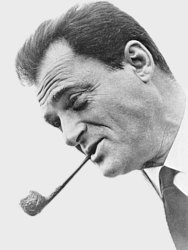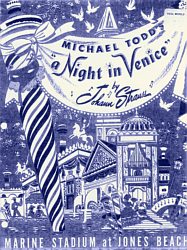
During the 1950s, the general public mostly thought of Mike Todd as someone involved in movies. However he was far more famous, and infamous, as a producer of big budget Broadway shows in New York. This biographical sketch of the man was included in the program for "A Night In Venice", a lavish blowout produced at Jones Beach in 1952.
It was hardly a surprise that showman Michael Todd
should be offered the operation of this magnificent
showplace. Who, but the producer of 30 Broadway
productions including such hits as "The Hot Mikado,"
"Something For The Boys," "Up In Central Park," "As The
Girls Go" and "Peep Show," could conceive a show
befitting this breathtaking theatre?
Mr. Todd is Mr. Showman. He has injected showmanship
into everything he has undertaken. In his first job as a street
corner pitchman in Minneapolis, he plunged a collapsible
knife into his neck until a crowd gathered. Then the
enterprising maestro calmly made his pitch to the
astonished customers.
At the age of 17 he built a multi-million dollar
construction business, which, alas, evaporated in '29.
He went to Hollywood, where as a contractor, in the early
days of the "talkies," he made his initial entry into
show business. It was there that he decided to become a
producer. He returned to Chicago and produced a
spectacular number, "The Flame Dance," at the Century of
Progress Fair. Making a success in this, the unpredictable
Mr. Todd reversed the field and took a unit of the Chicago
Opera Company on a tour of Gilbert and Sullivan's
"Mikado." Ever resourceful, at the closing of "The Mikado."
he used the scenery and costumes to produce two more
shows in Chicago - these production credits set the stage for
future efforts on Broadway.
Pulling another reversal, Mr. Todd produced a device
whereby the children, during the Christmas shopping
season, could see Santa Claus through a peephole while he
worked at his bench. To speak to him the children merely picked up a phone next to the
peephole. (A few years later Michael Todd parlayed a
peephole into a Winter Garden smash). By netting $200,000
on the Santa Claus peephole windfall, the versatile
showman burst on the Broadway scene with "The Hot
Mikado." Not being content in merely having a Broadway
hit, Mr. Todd, after seven weeks, while the show was still
playing to standees, moved out to the World's Fair grounds
and made his first invasion of Long Island. Naturally, "The
Hot Mikado" became one of the biggest hits at the Fair. The
next year Mr. Todd had four hits at the Grover Whalen
playground: "The Streets of Paris," "Gay New Orleans,"
"Opry House," and "Dancing Campus."
Shortly afterward Mr. Todd formed, to the great delight of
theatre-goers, the producer-star combination of Michael
Todd-Bobby Clark, an association which extended through
five shows: "Star and Garter," "The Would-Be Gentleman,"
"Mexican Hayride," "As The Girls Go" and "Peep Show," in
which Mr. Clark served as the director. Other hits that have
been brought to Broadway under Mr. Todd's banner have
been: "Something For The Boys," starring Ethel Merman;
"Pick-Up Girl"; "Catherine Was Great," starring Mae West;
"Up In Central Park"; and "Hamlet," starring Maurice Evans,
which set the record for the longest run of any'
Shakespearean play on Broadway.
Presently associated with Lowell Thomas in the
production of three-dimensional films, Mr. Todd returns to
Long Island, the scene of one of his, greatest triumphs, to
bring his own flair of showmanship to Jones Beach.
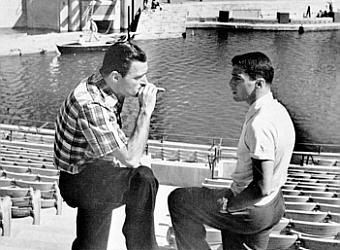
Seen above are Mike Todd and Mike Todd Jr. at Marine Stadium during production of A Night in Venice. Todd, the younger, was barely in his twenties at the time but he would wind up directing the most famous motion picture sequence since Scarlett O'Hara wandered through the train station. It was Mike Jr. who photographed the rollercoaster sequence for This Is Cinerama and directed nearly all the European photography in the film including the famous canals of Venice segment.
|
| 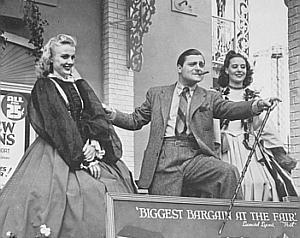
While Fred Waller was contemplating panoramic films on curved screens at the 1939-1940 New York World's Fair, Mike Todd was doing what he did so very well. He's seen here barking for attendance to one of his girly shows that were a hit at the fair. Looks a bit like a slave auction, but we assume it isn't.
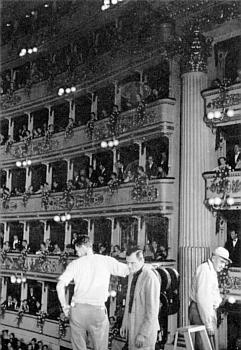
Jack Priestly, Mike Todd, and Harry Squires at La Scala in Milan during the filming of Aida. They seem to be looking for something. Since neither Todd nor Squires was ever seen without a cigar in their mouths, chances are they're trying to find a stogie.
Mike Todd left the Cinerama organization before the opening of This Is Cinerama in New York. There is a lot of misunderstanding regarding his departure. It is most often put off to friction between the partners. This was not actually the case. While there were a lot of differences in personality and temperament between the Cinerama pioneers, Todd's departure was done of pure financial necessity. Todd brought many valuable assets into the organization, top among them was a keen sense of showmanship. But he also brought a history of financial calamity and it was becoming apparent that the company could not make a public stock offering if Todd was part of the package. So he was bought out, quite handsomely, and he went off to duplicate Cinerama with a single film system, ultimately resulting in Todd-AO, a very successful 70mm process. It was not Cinerama, but it came close, at least until Hollywood got involved and reduced it to a very high quality wide screen system but without the wide angle photography and curved screen that had put it into business.
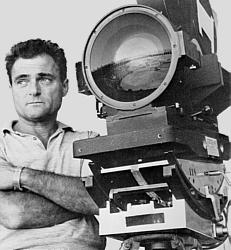
Todd took several hundred thousand of his Cinerama dollars and with the help of American Optical came up with Todd-AO, which he hoped would be like Cinerama except "everything comes out of one hole."
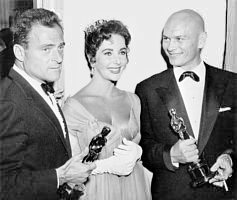
|
